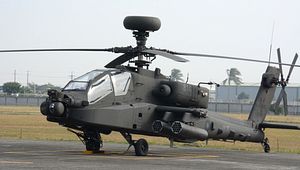Military enthusiasts in Taiwan had reason to rejoice on December 13. The Republic of China Army (ROCA) held an official ceremony at an Army base in Greater Tainan, Southern Taiwan, for the delivery of the first six of 30 Boeing AH-64E Apache “Guardian” attack helicopters ordered from the U.S.
For those who follow military developments on this side of the Taiwan Strait, the introduction of a new combat platform was a welcome change after years of seeing the same weapons systems operate during military exercises, a stark contrast with all the action that has been observed within the People’s Liberation Army (PLA) on the Chinese side.
The six AH-64Es, delivered on November 4, were part of a $6.4 billion arms package notified to U.S. Congress in 2008. The second delivery is expected in early 2014, with all 30 set to enter service in the Army by the end of 2014. The Apache helicopters accounted for $2.53 billion of the total arms package (the notification also included 1,000 AGM-114L Hellfire missiles and 66 M299 Hellfire Longbow missile launchers).
Taiwan, which had initially ordered the AH-64D Block III under the Tian Ying, or “Sky Eagle” program, was the first international client for the Guardian model, which attained initial operating capability (IOC) in the U.S. Army in November 2013.
The “Echo” model — the most advanced in the Apache family — comes equipped with the AN/APG-78 “Longbow” Fire Control Radar, which automatically searches, detects, locates, classifies, and prioritizes fixed and moving targets on land, sea, and in the air in all weather environments and battlefield conditions.
The Apache Guardian is armed with an M230 30mm chain gun, which can fire up to 625 high-explosive dual-purpose rounds per minute, and can be configured to carry AGM-114L “Hellfire” air-to-ground missiles (a total of 16 for anti-armor missions), AIM-9 “Sidewinder” air-to-air missiles, and Hydra 70 2.75-inch rockets.
Among the many advantages of the AH-64E are its improved composite main rotor blades, which are 15cm longer than those used on older models, as well as a new tip design and General Electric T700-GE-701D engines, all of which give the aircraft improved aerodynamic performance.
Moreover, the AH-64Es’ new power-to-weight ratio makes it safer for low-altitude operations and gives it a performance similar to that of the AH-64A, which was significantly lighter than the AH-64D Block II model. It also uses new software that allows pilots to control unmanned aerial vehicles (UAV) and their payloads.
More than 60 Taiwanese Army pilots began undergoing training on the AH-64E at an Army base in the U.S. in November 2012. The Apache Guardian will bring much needed muscle to the ROC Army’s Bell 60 AH-1W “Super Cobra” attack helicopters, which it acquired in 1990. Arguably the deadliest combat helicopter on the face of the planet at present, the “Echo” is capable of conducting both land- and sea-based operations. In wartime, the AH-64E would play a major role in countering amphibious attacks or landings by enemy forces.
The acquisition of the Apache Guardian wasn’t without its critics, who argued that Taiwan would have made a better investment by upgrading its existing AH-1W to AH-1Z “Zulu Cobras” (or “Viper”) and acquiring 30 more. However, Taiwan’s defense procurement calculations often cannot simply be assessed on the basis of defense value-per-dollar, and must also include the political signaling that is associated with a sale. In this case, and especially after Taiwan became the first international client for the Apache Guardian, Washington’s decision to proceed with the sale had a profound psychological impact in Taiwan, which is keenly sensitive to any sign that the U.S. might “abandon” its ally, or cease arms sales to the island under pressure from Beijing.
Other critics have pointed out that however formidable the AH-64E might be — and it truly is — the helicopters would likely be “sitting ducks” during any war scenario where the PLA Air Force (PLAAF) established air superiority in the Taiwan Strait. This scenario is becoming increasingly feasible given the widening gap between the ROCAF and the PLAAF and China’s ability to neutralize Taiwan’s airfields using ballistic and cruise missiles in the initial phase of hostilities.


































